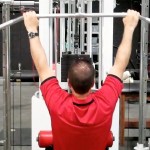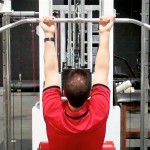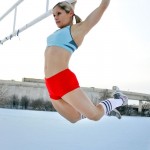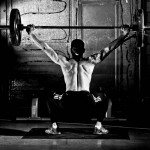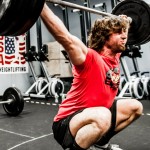Brian Schiff’s Blog
Injury Prevention, Sports Rehab & Performance Training Expert
I am big fan of lat pull downs and pull-ups. I think when done properly, this is a fantastic way to improve postural strength and safeguard the shoulder against injury. In April 2012, I wrote a column on lat pull downs addressing shoulder pain (click here to read that post).
I decided to add to that previous post and discuss a recent article published in the February NSCA Strength and Conditioning Journal. In the article, the authors present some research regarding how altering hand orientation and grip width affects muscle activity during the exercise.
Grip Width Summary
Lehman J Strength Cond Res 2005
- No significant difference between narrow supinated grip and wide pronated grip with biceps and latissimus dorsi
- Highest level of latissimus dorsi activity occurs with seated row with retracted shoulders
Lusk et al. J Strength Cond Res 2010
- No difference in biceps, latissimus or middle trapezius activity (note – wide grip only slightly larger than narrow grip)
Sperandei et al. J Strength Cond Res 2009
- In front of the head pull downs with standardized width and hand orientation revealed higher activation for posterior deltoid and latissimus compared to behind the neck
- This study did NOT compare different grip widths
Hand Orientation Summary
Youdas et al.J Strength Cond Res 2010
- Pronated grip during pull-ups (56 +/- 21% MVIC) was most effective for activating the lower trapezius compared with the supinated grip
- Pronated grip also resulted in greater infraspinatus activation (45 +/- 22% MVIC) compared with the perfect pull-up
- Perfect pull-up showed higher latissimus activity (130 +/- 53% MVIC) than the supinated grip of a chin up
- Supinated grip of the chin-up revealed an increase in pec major (57 +/- 36% MVIC) and biceps brachii (96 +/- 34% MVIC) versus 44 +/- 27% (pec major) and 78 +/- 32% (biceps brachii) for the pronated version
- Posterior deltoid showed no difference in all hand orientations
Lusk et al. J Strength Cond Res 2005
- Pronated grip during lat pull-downs elicited a 9% greater muscle activation of latissimus dorsi compared to supinated grip
- No difference between middle trapezius and biceps brachii in pronated or supinated grip
My Takeaways
- If your goal is maximizing latissimus activity and improving scapular stabilizer and rotator cuff function opt for the pronated grip
- Supinated grip elicits greater activation in the pectoralis major and biceps – no surprise here based on physics and kinesiology -> easier for clients to do and also not going to stress the shoulder as much in the presence of any inflammation or pathology
- Range of motion, scapular dyskinesia, pain, soft tissue restrictions and imbalances play a vital role for each client so they may need some preparatory work to make the most of this exercise
- Small tweaks (in my opinion) can make a big difference in comfort level and performance of the exercise (refer to number 3 for why) so do not be afraid to experiment between wide and narrow in a pronated grip
- The authors mention that if individuals elect to do the behind the neck version they should have adequate range of motion to do it safely. Let me be clear – there is NO reward big enough to justify the risk involved in doing behind the neck pull-downs. Save your neck and shoulders by eliminating this option altogether as I would bet most of us do not have perfect bony anatomy, mobility and optimal muscle firing throughout the motion to ensure that potential repetitive micro trauma will not occur over time.
For my CrossFit friends – optimal shoulder mobility, scapular stability and adequate thoracic spine extension and rotation is a must to minimize risk with kipping and less than perfect pulling form. I much prefer unweighting or assisting the body through pull downs, bands or partner assists to build pre-requesite strength initially until the client is better able to manage the movement under full body weight.
Quality movement ABSOLUTELY matters over hundreds and thousands of reps.
As far as research goes, I think we still need further studies on grip width and specifically how it may directly impact not only muscle activation but force on the glenohumeral joint itself. For me, I opt for pronated pull-ups and or pull-downs once per week with a moderate grip width in my own routine. I hope this information serves you well. Happy lat training!!
So, I treat a number of fitness enthusiasts in the clinic and many include Crossfit clients. Recently, I evaluated a 38 y/o male on 2/16/12 with a 3 month history of right shoulder pain. He performs Crossfit workouts 6 days per week. His initial intake revealed:
- Constant shoulder pain that worsens with overhead movements
- Pain with bar hangs, overhead squats and wide grip snatches
- Unable to do kipping (only doing strict form pull-ups)
- Pain if laying on his right side at night
- No c/o neck pain, referred pain or numbness/tingling
Notice the shoulder position during the kipping pull-up and overhead squat below. This is a position of heightened risk for the shoulder.
His exam revealed the following:
- Normal range of motion
- Strength within normal limits except for supraspinatus and external rotation graded 3+/5 with pain
- Positive impingement signs
- Negative shrug sign
- Negative Speed’s and O’Brien’s test
- Tender along distal supraspinatus tendon
Based on the clinical exam, it was apparent he had rotator cuff inflammation and perhaps even a tear. Keep in mind he had not seen a physician yet. I began treatment focused on scapular stabilization and rotator cuff strengthening as well as pec and posterior capsule stretching to address the impingement. Ultrasound and cryotherapy were used initially to reduce pain and inflammation.
One month following the eval
By 3/14/12, his pain was resolved with daily activity and he had returned to snatches and push-press exercises without pain. He still could not do overhead squats with the Olympic bar pain free, but he could with a pvc pipe. Strength was now 4/5 for supraspinatus and 4+/5 for external rotation. All impingement tests were now negative as were Speed’s and O’Brien’s testing.

